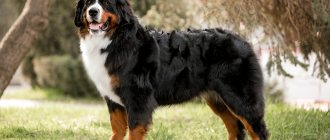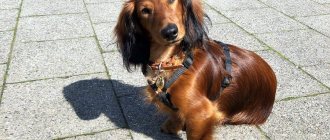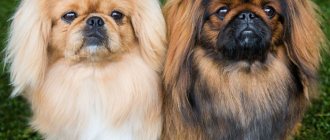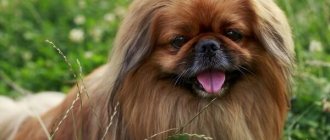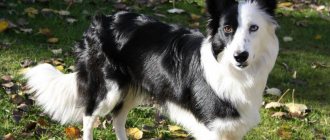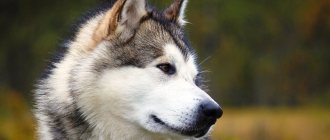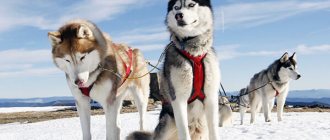| Origin | Switzerland |
| Usage | Herd protection, grazing, pack animal in the mountains |
| Color | A combination of three colors - black (main), red along the line of the paws and in the form of specks on the muzzle, white - from the forehead to the belly. |
| Dimensions | Large Swiss - from 50 to 68 kg; height – from 60 to 73 cm. Bernese – from 36 to 50 kg; height – from 58 to 70 cm. Entlebucher – 25 – 30 kg; height – from 42 to 50 cm. Appenzeller – from 22 to 32 kg; height – from 47 to 58 cm. |
| Lifespan | Large Swiss and Bernese Shepherds – 10 – 12 years. Entlebucher and Appenzeller live from 12 to 15 years. |
Sennenhunds have a long history. Dogs resembling them in appearance were discovered during excavations of a legionnaire camp of the Roman Empire. The agile dog helped protect flocks of sheep from predators. They retain their shepherd's inclinations even when living in apartments and take care of the safety of family members. The question of dog breed ownership remains unclear to this day: to which group they should be classified. It is believed that Sennenhunds may be relatives of Schnauzers, Molossians or Wolf-Molossians.
Other names for Sennenhunds are herding dogs and Swiss shepherds.
Breed standard
All Mountain Dogs have proportional shapes, sizes, and characteristic colors:
- Powerful Greater Swiss have a height of up to 72 cm; Bernese - from 58 to 70 cm, Appenzeller -50-58 cm; entlebuchers - 42-50 cm. Females are usually smaller than males.
- Color - tricolor. The standard fixes the location of brown inserts and the distribution of white color. The photo of all representatives of the Sennenhunds shows that they differ only in size and length of coat.
- Wool. All types of Mountain Dogs are short-haired, except Bernese.
- Large round head.
- Powerful neck with developed muscles.
- Broad chest and not long body with a wide chest.
- Drop triangular ears.
- The nose is black. The muzzle is white.
- The eyes are brown, almond-shaped.
- The tail is fluffy with a white tip in the Bernese Shepherd; in species with short hair, the tail is long or medium, dense. The Entlebucher's tail may be short, congenital, or long.
Story
There are many ambiguities and “blank spots” in the history of the Sennenhunds. What is known for certain is that this is a very ancient breed. In everything else, regarding the origin, the opinions of experts differ. Some dog handlers consider these strong and majestic animals to be the descendants of the fighting dogs of the Roman legionnaires who conquered the territories of modern Switzerland and France. Other dog experts believe that the ancestor of the Mountain Dog was the Tibetan Mastiff, considered the ancestor of all Great Dane breeds.
The fighting dogs that came to the territory of Switzerland and France quickly changed their original purpose. After all, the people living in these areas were not engaged in battles, but in peaceful labor, and they had a need to breed a strong, powerful dog that would help herd and protect livestock from wolves and other predators, and at the same time protect the house from robbers and deserters, who there were plenty of those troubled times.
In the old days, there was no division of Sennenhunds into breed varieties. In one litter, both large and medium-sized puppies were born with different types and lengths of fur, and sometimes with different colors, although already in ancient times the predominant color was black-white-red tricolor.
As for the Pyrenean mountain dog, despite its common origin with all Sennenhunds, from the very beginning it differed in color from other breeds similar to it. And its history is also noticeably different.
Unlike the Swiss breeds, the Pyrenees were lucky enough to fall into favor with the French kings and become court dogs. It so happened that one day Louis XIV, known as the Sun King, while touring his possessions, drew attention to the huge and majestic white dogs that lived only in the Pyrenees. The king immediately fell in love with these giants and wanted to take the aboriginal dogs into the palace. Intelligent and intelligent Pyrenean mountain dogs were declared by him to be a court breed, and puppies born from royal favorites and presented to them by a courtier were considered the highest sign of royal favor and favor.
True, during the French Revolution, the court “Pyrenees” had a hard time, but due to the fact that the breed was originally a working breed, it managed to survive and subsequently regain its former popularity.
And other Sennenhunds, which experts finally paid attention to at the beginning of the 20th century, also became popular, not only as working dogs, but also as show dogs. Their beauty, majestic strength and power allowed these dogs to win the love of millions of people, and their wonderful affectionate and obedient character made them suitable for working as guide dogs, as well as animals suitable for canine therapy.
They are also used as search dogs, as well as rescue dogs used in eliminating the consequences of natural disasters such as rock falls, earthquakes, landslides, avalanches, etc.
Mountain dogs received official recognition already in the 20th century, and around the same time, the division of one original breed into varieties began, differing from each other both in size and in some exterior features. Currently, all Sennenhunds are officially recognized dog breeds, each of which has its own standard.
For those who are interested in how the word “Sennenhund” is translated: it is composed of 2 parts - Hund (German der Hund) dog and Zenen (German der Senne) alpine shepherd or meadow.
Character
All Mountain Dogs are loved due to their beauty and friendly, calm nature. It is these qualities that are prioritized by the standard. Peaceful animals leave the most pleasant impressions. Their performance characteristics make them useful and in demand.
All Mountain Dogs become very attached to the family into which they are adopted. Separation is difficult for them.
Greater Swiss Shepherd (gross)
A working dog that feels comfortable in outdoor conditions. May show self-will and stubbornness. Requires intellectual activities and contact with the owner.
Bernese Shepherd
A friendly, peace-loving and flexible dog. Treats all family members with care. Does not show aggression towards strangers. When danger threatens family members, the Swiss Mountain Dog instantly forgets that by standard he is friendly and peaceful, and fiercely protects his household.
Appenzeller
An active dog that requires regular training. Not aggressive. She is suspicious of strangers.
Entlebucher
The cheerful dog shows herding tendencies both on the farm and in an apartment, where the “herd” is a family, including cats and other pets.
Representatives of the breed with a documented pedigree behave in accordance with the description of the standard. Mestizos can fully inherit the characteristic characteristics of the breed, but often behave unpredictably.
Entlebuch (entlebucher)
A distinctive feature of this species is its small size. It appeared in the Entlebuch valley.
The first mention of Entlebuchers was made in 1889, but there were no significant differences from other types of Mountain Dogs.
As for character: this breed is self-confident, fearless and, as a contrast, cheerful and perky.
To say that the entlebukh is devoted to his “native” people is to say nothing.
He also retains his guard qualities and is easy to train.
The Entlebucher's qualities of calm and poise continue to fascinate people.
The dog has a strong body and is capable of protecting not only herds, but also the owner’s extensive property, and an entire domestic brood - children and other animals.
In general, we can say this about Mountain Dogs: these dogs are simple, smart and brave. They are adapted to life in a family as a full member.
Sennenhunds become good friends and share the owner's interests in sports and an active lifestyle. They don't like to be alone. These dogs should not be “forgotten” in the backyard; they should definitely be near people.
Application
Sennenhunds are historically Swiss herding dogs. In some mountainous areas, large breeds continue to be used as herders. Small ones - used as companions. In mountain rescue teams, all Sennenhunds are used as rescuers to search for lost and injured people.
They can be security guards and perform watchdog functions. The breed is not aggressive. Sennenhunds attack extremely rarely. Calm, good-natured - they are ideal nannies for a child.
Nutrition
Feeding recommendations for Mountain Dogs are the same as for all large dogs. It is important to observe the frequency of feeding and portion size.
Grosses love to eat, but overeating is not healthy for them at all. After eating, the dog needs to rest; at this time it should not be burdened with exercises or walks.
Socialization
The Mountain Dog, having a friendly character, treats all family members with equal love, although it becomes attached to one person. Herding instincts are inherent at the genetic level, so even a dog who is passionate about play always controls the safety of the “herd.”
Sennenhunds cannot stand being alone. A change of owners can negatively affect the psychological state of the animal.
Herding Shepherd Dogs show politeness to strangers, but do not allow familiarity from strangers. Pets are treated like family members. They don't compete for the top position. Domestic cats often take advantage of their gentleness and good nature, from which the Mountain Dog would prefer to retreat rather than engage in a fight. They love to play with children.
All Mountain Dogs have highly developed intelligence, are easy to train, and are good listeners. Grosses require additional mental stress.
Interesting Facts
Few people know that at the end of the 14th century, the burgomaster of Zurich issued a decree banning the keeping of large dogs. According to this decree, all Berns were subject to death, as they destroyed the vineyards of wealthy wine farmers. Ordinary farmers and city residents stood up for the good-natured animals, and the burgomaster himself was executed.
This is not the only interesting fact about these dogs:
- The Bernese Mountain Dog has two other official names: Bernese Mountain Dog and Dürrbächler;
- Berns do not have any special guarding abilities, but they can create a formidable appearance. Dogs bark loudly at strangers, but do not try to detain them;
- When the breed was at the peak of its popularity, people flocked to Switzerland to purchase a good-natured giant from local farmers for a fairly impressive amount of money;
- The tricolor color of the Bernese Mountain Dog gave the animal a mystical quality. Many ancient Alpine residents believed that through Sennenhunds they could turn to the gods, since dogs were given another pair of eyes for this - tan;
- Bern is not so much a reliable guard as an excellent assistant. Previously, these animals helped people transport carts and carts. During the war, Swiss Shepherds carried small artillery pieces. Over the two thousand years of the breed’s formation, the dogs completely lost their hunting instincts;
- The Bernese Shepherd belongs to the second group according to the FCI qualification, section number 3 - “Swiss Cattle Dogs”.
How to choose a puppy
The best place to buy a puppy is a nursery or from breeders with a good reputation and recommendations. Before purchasing, you need to check the documents confirming the pedigree and look at the conditions of detention. The optimal age for purchasing a puppy is 2 – 3 months. During this period they are already quite independent.
When choosing, you should take into account the developmental characteristics of individual breeds:
- Swiss Greater Mountain Dogs and Bernese babies develop more slowly than others. They begin to hear and see after three weeks. Until this age, they develop other ways of perceiving the world around them - smell, touch. For future socialization, the period of appearance and hearing is the most important. At this moment, the puppy’s fear can affect the formation of its character in the future, making it fearful and anxious.
- Appenzellers and Entlebuchers develop quickly. From an early age they show curiosity and activity.
You don't choose a puppy based on a photo. Directly at the nursery you need to pay attention to some important points:
- Externally, babies should look well-fed, strong, with powerful paws and an impressive constitution.
- Behavior – active, inquisitive, without the slightest signs of fear.
- They should not be frightened by loud noises or strangers.
- Correct bite.
- Eye color. Blue ones are unacceptable.
- The gait is wide and sweeping. Small mincing steps are unacceptable for representatives of this breed.
- The paws are strong, without bending. There should be no lameness.
Lifespan
Wonderful companions
Of course, when getting a pet, every breeder wants to know how many years he can live. And here the numbers are very sad - the average life expectancy of Bernese Mountain Dogs is from 6 to 8 years. Needless to say, this is very little even by the standards of all large breeds, among which long-livers are rare.
However, you should not refuse to purchase a puppy from a kennel because of this. Still, this period is very average. That is, both young dogs who die at 4-5 years old and older dogs who live to be 12-14 years old end up here.
If you provide your dog with good conditions and carefully monitor their health, they will live quite a long time and delight others.
Features of maintenance and care
All varieties of the breed do not require special care, especially the short-haired representatives. It is enough to comb them during molting.
Bernese Shepherds require more attention - they need to be brushed often, as they shed profusely and constantly. If the fur is dirty, you can bathe it.
It is necessary to keep the ears clean and regularly wipe the inner surface with a cotton pad soaked in hygienic oil. Trim nails and brush teeth periodically.
Appenzellers and Entlebuchers need active walks, and Grossies (large Swiss Shepherds) need regular exercise. You can go for short distance runs while monitoring your pet’s condition. The Bernese Mountain Dog should not be overtired.
The main thing when keeping shepherd dogs is friendly relations and attention. Mountain Dogs love to play. You can do this both at home and while walking outside.
All species of this breed need to be trained in order to ultimately obtain an intelligent companion who is predictable in his behavior and actions. Harsh training is unacceptable.
Aggression and a raised voice are not acceptable when raising Swiss Cattle Dogs.
Regular classes aimed at consolidating certain skills and memorizing commands will give the desired result with the owner’s benevolent persistence and patience.
Combing
Mountain Dogs' coat is naturally shiny and silky. Not all Mountain Dogs shed heavily. Therefore, short-haired dogs are brushed with a damp special mitten once a week, long-haired dogs are combed out more often - 2-3 times a week. If this is not done in a timely manner, the lost hair will get into shreds, forming tangles. They should be cut off as they cause pain to the dog by tightening the skin. In addition, an animal with mats looks unkempt.
Seasonal shedding occurs twice a year, and during this period the fur falls out especially intensively. The number of combings needs to be increased. In summer, if dogs suffer from the heat, they can be cut.
Bathing
You should bathe your Mountain Dog when its fur is very dirty. It is not advisable to carry out the procedure more than once a month.
Walk
The Bernese Mountain Dog, despite its impressive growth and developed muscular system, does not like much physical activity. They quickly use up the energy accumulated between walks. After a burst of vigorous activity, the Swiss Shepherd prefers a leisurely walk with the owner or will be happy with the opportunity to simply sit next to him and watch what is happening around him.
Grosses are large, hardy dogs, so they need exercise and long walks. Entlebuchers and Appenzellers love walks. Active games are necessary for their good mood and well-being.
Nutrition
The diet for both a large dog prone to obesity and a medium-sized dog needs to be carefully selected. Improper nutrition can cause deterioration in health, impaired development of puppies, hair loss, and skin diseases.
An important part of the diet is the vitamin complex. Vitamins are necessary for the proper formation of soft and bone tissues and the normal functioning of internal organs. Before giving vitamins, you should consult your veterinarian.
Puppies' diet should be high in protein. Babies are actively growing and they need this component for proper and complete formation and growth. Up to 6 months, feeding is done at least 5 times a day. By six months, the number of meals is gradually reduced to 3 times. Adult dogs are fed twice a day - morning and evening, at the same time.
Since Mountain Dogs are not dogs that lead an active, mobile lifestyle, the protein content in their daily diet should not exceed 28%. The minimum amount is 18%.
Proper nutrition for Mountain Dogs includes:
- Offal and meat. It should be given with a high content of veins and cartilage. Be sure to include tripe in your diet. Firstly, they love it, and secondly, it is good for the digestive system.
- Cereals in the form of porridges cooked in water.
- Fruits, vegetables, raw or boiled.
- Cottage cheese.
- Sea fish, because it is rich in microelements and phosphorus. It is included in the diet once a week.
- Raw chicken egg, 1 – 2 pcs. once a week.
The food bowl should be removed immediately after finishing feeding, even if there is some left over. Clean drinking water must be available at all times.
An alternative feeding option is dry food. It must be premium or super premium. Fat content is minimal. It must be taken into account that large representatives have a tendency to be overweight.
Nutrition, quantity and regimen must be taken responsibly. Feeding should be done at the time and in the volumes required by the breed, taking into account weight and age.
Sprinkling food between feedings, arguing that the dog is looking with hungry eyes, is not acceptable. It is strictly forbidden to give sweets, salty foods and smoked foods.
Is it difficult to keep a Bernese Mountain Dog?
The thick, long hair of Bernese Shepherds creates natural difficulties in grooming. If the dog is not accustomed to wearing protective overalls, then in the off-season he will bring a colossal amount of dirt into the house. The wet fur of a mountain dog smells like a dog. Although this cannot be attributed to breed characteristics - in all dogs the smell intensifies if they are wet.
During the seasonal shedding season, your Bernese's fur will be everywhere. Its amount can be reduced by combing the undercoat with a furminator. At other times, regular brushing is also necessary to keep the coat smooth and shiny. In the summer, weed seeds (burdock, mignonette) and other debris are carefully removed from it.
Combing out the undercoat can be difficult
Convenient to brush your pet outside
A huge advantage of Mountain Dogs is their dry, closed lips - these dogs, unlike St. Bernards, are not slobbery at all. However, Berns can make a mess around bowls of water and food. As well as making a mess in the house, simply swinging its powerful tail like a club and hitting the furniture with its massive thighs.
Many people call their Mountain Dog a sloth, noting that the pet doesn’t mind lying on the couch instead of going for a walk in bad weather. A calm temperament is both a plus and a minus. On the one hand, two long walks a day and moderate games are enough for Bernese. But if laziness is encouraged, it can lead to obesity and problems with joints and ligaments.
Let's just lie on the couch, master!
It does not seem obvious to everyone that the size of a dog is directly proportional to the cost of maintaining it. Berns are very large, the average weight of an adult dog is about 40 kg. This means spending a lot on food every month. Even the bill at the veterinary clinic will be many times higher than for a small dog due to the high consumption of medications and consumables.
This little one will grow up quickly
Health
Large Mountain Dog puppies develop quite slowly. Full maturity occurs at 2 years. Large dogs develop bones slowly, so puppies should be exercised moderately to prevent injury.
Hereditary diseases in puppies are difficult to identify. We have to rely on the integrity of the breeders conducting breeding.
Diseases
The herding dog is in good health. But large Sennenhunds are prone to joint diseases - elbow and hip dysplasia, and can also develop pancreatitis and bursitis.
Diseases transmitted by inheritance are detected at different ages:
- Joint dysplasia in dogs can appear at 5 months, but it is usually diagnosed in eight-month-old puppies.
- Cancer. It is difficult to treat. The earlier the disease is detected, the greater the chance of saving the dog.
- Panostitis. Bone disease. It can be diagnosed from 5 months. Manifests itself in the form of lameness.
- Hypothyroidism. Can be detected up to 2 years. Externally it manifests itself as brittle wool and increased temperature. With further development – weight gain.
- Allergy.
- Gastric volvulus. May occur during physical activity immediately after eating.
- Eye diseases: retinal atrophy, entropy, cataract.
Vaccinations
Mountain dog puppies need to have their vaccinations as scheduled. You should consult your veterinarian about the sequence and timing. Vaccination against rabies and plague is mandatory.
Distinctive features
According to the standard, the Greater Swiss Mountain Dog should look like this:
- The head tapers towards the muzzle, large and wide. The width of the muzzle is 2 times less than the width of the skull, the length is equal to the length of the skull. The furrowed forehead smoothly transitions into the bridge of the nose.
- The jaws are strong. Lips are black, not drooping. Full, scissor bite. The absence of premolars is allowed.
- The nose has a flat back, without a groove. The nose is large, protruding, black, large.
- The eyes are small, almond-shaped, of various shades of brown, not protruding or depressed.
- The ears are triangular in shape, flat, set high, close to the head. They can rise and turn forward towards sound.
- The neck is not too long, strong, without folds.
- The body is rectangular with a long and wide croup, slightly tucked sides and belly. The chest is wide and quite powerful.
- The tail is thick, slightly curved upward, but not curled. Usually hangs down, may be raised slightly above the croup, but does not hang over the back.
- The paws are muscular, smooth, widely spaced parallel to each other. Dewclaws should be removed from the hind legs.
- The coat is of medium or short length, with thick topcoat and dense undercoat, always black or dark gray.
- The color consists of three colors. The color is predominantly black and there are a few russet and white spots. Red spots are located on the superciliary ridges and inside the ears, under the tail; They are also located next to the white spots on the muzzle, on the front of the chest, and on the bottom of all four legs. The tail ends with a small white spot. The requirement for spots is symmetry.
- The character is calm and friendly.
All significant deviations from the traits inherent in the breed are considered obvious defects and are assessed according to the degree of severity. Particularly serious defects lead to disqualification.
Mating
Swiss Cattle Dogs become adults at 2 years of age. Therefore, despite the fact that dogs have their first heat every year and then every six months, they cannot be bred until they are fully mature. After birth, the next mating takes place a year later. Bitches over 7 years old do not participate in breeding.
How much do mountain dog puppies cost?
In the nursery you can buy puppies of different categories with the following pedigree:
- Without participation in exhibitions and breeding - from 20,000 to 25,000 rubles.
- For an exhibition career and breeding - from 35,000 to 40,000 rubles.
- Rare species (entlebucher) - from 40,000 to 60,000 rubles.
Nurseries
The Mountain Dog is one of the most popular dogs. In Russia, you can buy a puppy in a kennel or from breeders:
- in Moscow, the nursery “Village of Berntsev”bernendorf.ru;
- in St. Petersburg – spb-zennen.narod.ru/
The Swiss Mountain Dog is a wonderful friend, companion, and guard. Characteristics and temperament make him a full-fledged member of the family, caring and kind. In order for the dog to feel loved (this is very important for this breed), it is necessary to take care of him: devote time to walks, education, and games. When choosing a mountain dog as a pet, you need to be 100% sure that he will not have to change his home and family during his life.
Description
The description of the Greater Swiss Mountain Dog breed can be limited to one phrase - it is a very large dog. Its height will be about 70 centimeters for a male, 5 centimeters lower for a female. The weight of the Greater Swiss Mountain Dog reaches 70 kilograms.
The dog's coat is tricolor: black with brown-red or red tan. The muzzle and chest are decorated with a white pattern; the same white socks and collar are allowed.



